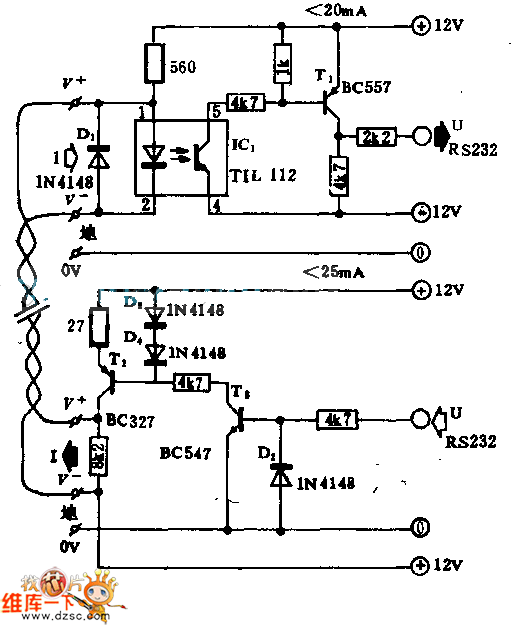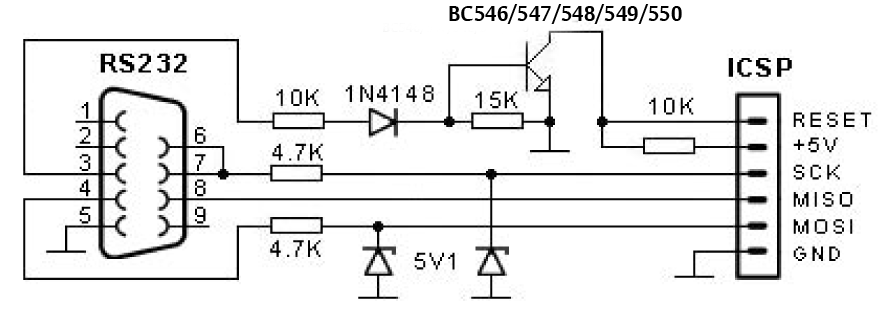
Parallel Port CW Interface for N3FJP

I have been participating in CW contests using my K2 and N3FJP's logging software. With my modern rig featuring computer control, I aimed to connect it to my old ThinkPad, utilizing the serial port for rig control and the parallel port for keying. There has been discussion regarding the possibility of running both rig control and keying from the same serial port. Additionally, concerns have been raised about the parallel port being an unreliable, RF-sensitive interface. However, I prefer to keep the K2 serial line "pure" and implement keying through a separate circuit. In practice, the final circuit has functioned correctly without RF issues. N3FJP's website provided a serial schematic, and he later added a transistor-driven parallel schematic. Despite extensive searches online for an opto-coupled parallel port circuit yielding no results, I decided to create my own interface, which prompted the creation of this page to assist others. I purchased a stereo headphone extension cable from Radio Shack, cut it, and mounted the interface components in a 25-pin D-shell. The schematic was hand-drawn and scanned for simplicity. Calculating the appropriate value for the current-limiting resistor in the line driving the LED in the opto-coupler involved significant effort. Assistance from the Elecraft Reflector, particularly from Dale, KK6RK, led to the conclusion that a 390-ohm resistor would supply the necessary 8-9 mA to the LED. However, determining the current sourcing capability of the ThinkPad's parallel port proved challenging. Eventually, a 1K-ohm potentiometer was introduced into the circuit, allowing for adjustments while sending signals from the computer. Reliable keying was achieved around 130 ohms, with 100 ohms also performing well. Although this method is effective for determining a workable value, a fixed resistor is intended to replace the potentiometer due to its sensitivity to physical adjustments. The 1N5817 diodes in the keyline, which activate the K2's autodetect keying circuit, have demonstrated excellent performance. Observations from the Elecraft reflector suggest that these Schottky rectifier diodes exhibit favorable timing characteristics for this application, as they activate simultaneously without causing confusion for the K2.
The described circuit integrates a K2 transceiver with a ThinkPad laptop for CW contesting purposes, utilizing both a serial port for rig control and a parallel port for keying functionality. The design aims to maintain signal integrity by segregating keying from the serial communication line, addressing concerns regarding the susceptibility of parallel ports to RF interference.
The core of the interface involves an opto-coupler, which serves to isolate the computer's parallel port from the K2, ensuring that the keying signal is clean and free from potential noise. The choice of a 1N5817 Schottky diode in the keying line is particularly significant, as these diodes are known for their low forward voltage drop and fast switching capabilities, making them suitable for high-speed applications like CW transmission.
The use of a potentiometer for fine-tuning the current through the opto-coupler's LED is a practical solution to accommodate variations in the output of the ThinkPad's parallel port. This adjustability allows for optimization of the keying signal, ensuring reliable operation without compromising the performance of the K2's autodetect feature. Eventually, transitioning to a fixed resistor will enhance the circuit's stability and reliability, reducing the risk of inadvertent adjustments that could lead to performance inconsistencies.
In summary, this circuit design not only meets the immediate requirements for CW contesting but also reflects a thoughtful approach to interfacing vintage and modern technology while maintaining signal integrity and performance reliability. The careful selection of components and the iterative process of tuning the circuit exemplify best practices in electronic design for amateur radio applications.I`ve been doing some CW contesting with my K2 and N3FJP`s Logging Software and since I now have this modern rig with computer control and everything I wanted to connect it up to my old Thinkpad and use the serial port for rig control and the parallel port for keying. Now, I`ve heard talk that you can run both rig control and keying off the same serial port and I`ve also heard that the parallel port is a crummy, RF-sensitive interface, but I really want to keep my K2 serial line "pure" and do the keying on a separate circuit. (In practice, the final circuit has worked fine and I haven`t had any RF problems. ) N3FJP`s web site had a serial schematic, and he has since added a transistor driven parallel schematic, but I looked all over the web for an opto-coupled, parallel port circuit and couldn`t find one, so after I finally built my own interface I decided to make this page and maybe save someone else some time.
I bought a stereo headphone cable extension cable at Radio Shack and cut it, then mounted the interface components in a 25 pin D-shell. The final product looks like this: The schematic looks like this (it was easier to just draw it on paper and scan it than fiddle with a drawing program, so please excuse the somewhat rough quality.
) I did a lot of math to figure out the right value for the current limiting resistor that is in the line that drives the LED in the opto-coupler. I even got a lot of help from the Elecraft Reflector, in particular Dale, KK6RK was very patient over several e-mails and figured a 390 ohm resistor would provide the needed 8-9ma to the LED.
But, in the end, it was very hard to figure out how much current my crazy Thinkpad parallel port could source and nothing seemed to work. That`s when I became a complete hack and dropped a 1K ohm pot into the circuit and twiddled it while sending from the computer until things started working.
I discovered I could start to get reliable keying around 130 ohms and 100 ohms worked well. I think this is a good way to get a workable value for a particular situation and I recommend it - though I do intend to swap out the pot for a- - fixed value resistor since the pot is "twitchy" and can be bumped out of value easily. The 1N5817 diodes in the keyline that activate the K2`s autodetect keying circuit work very well and I`ve seen some traffic on the Elecraft reflector that indicate these Schottky Rectifier diodes have good timing characteristics for this application (they turn on together and don`t confuse the K2).
MERCHANDISE: STOCK NUMBER ORDERED AVAILABILITY PRICE Ext. Price = 78-4N35 1 1 Ships Immediately 0. 290 0. 290 583-1N5817 2 2 Ships Immediately 0. 280 0. 560 🔗 External reference
The described circuit integrates a K2 transceiver with a ThinkPad laptop for CW contesting purposes, utilizing both a serial port for rig control and a parallel port for keying functionality. The design aims to maintain signal integrity by segregating keying from the serial communication line, addressing concerns regarding the susceptibility of parallel ports to RF interference.
The core of the interface involves an opto-coupler, which serves to isolate the computer's parallel port from the K2, ensuring that the keying signal is clean and free from potential noise. The choice of a 1N5817 Schottky diode in the keying line is particularly significant, as these diodes are known for their low forward voltage drop and fast switching capabilities, making them suitable for high-speed applications like CW transmission.
The use of a potentiometer for fine-tuning the current through the opto-coupler's LED is a practical solution to accommodate variations in the output of the ThinkPad's parallel port. This adjustability allows for optimization of the keying signal, ensuring reliable operation without compromising the performance of the K2's autodetect feature. Eventually, transitioning to a fixed resistor will enhance the circuit's stability and reliability, reducing the risk of inadvertent adjustments that could lead to performance inconsistencies.
In summary, this circuit design not only meets the immediate requirements for CW contesting but also reflects a thoughtful approach to interfacing vintage and modern technology while maintaining signal integrity and performance reliability. The careful selection of components and the iterative process of tuning the circuit exemplify best practices in electronic design for amateur radio applications.I`ve been doing some CW contesting with my K2 and N3FJP`s Logging Software and since I now have this modern rig with computer control and everything I wanted to connect it up to my old Thinkpad and use the serial port for rig control and the parallel port for keying. Now, I`ve heard talk that you can run both rig control and keying off the same serial port and I`ve also heard that the parallel port is a crummy, RF-sensitive interface, but I really want to keep my K2 serial line "pure" and do the keying on a separate circuit. (In practice, the final circuit has worked fine and I haven`t had any RF problems. ) N3FJP`s web site had a serial schematic, and he has since added a transistor driven parallel schematic, but I looked all over the web for an opto-coupled, parallel port circuit and couldn`t find one, so after I finally built my own interface I decided to make this page and maybe save someone else some time.
I bought a stereo headphone cable extension cable at Radio Shack and cut it, then mounted the interface components in a 25 pin D-shell. The final product looks like this: The schematic looks like this (it was easier to just draw it on paper and scan it than fiddle with a drawing program, so please excuse the somewhat rough quality.
) I did a lot of math to figure out the right value for the current limiting resistor that is in the line that drives the LED in the opto-coupler. I even got a lot of help from the Elecraft Reflector, in particular Dale, KK6RK was very patient over several e-mails and figured a 390 ohm resistor would provide the needed 8-9ma to the LED.
But, in the end, it was very hard to figure out how much current my crazy Thinkpad parallel port could source and nothing seemed to work. That`s when I became a complete hack and dropped a 1K ohm pot into the circuit and twiddled it while sending from the computer until things started working.
I discovered I could start to get reliable keying around 130 ohms and 100 ohms worked well. I think this is a good way to get a workable value for a particular situation and I recommend it - though I do intend to swap out the pot for a- - fixed value resistor since the pot is "twitchy" and can be bumped out of value easily. The 1N5817 diodes in the keyline that activate the K2`s autodetect keying circuit work very well and I`ve seen some traffic on the Elecraft reflector that indicate these Schottky Rectifier diodes have good timing characteristics for this application (they turn on together and don`t confuse the K2).
MERCHANDISE: STOCK NUMBER ORDERED AVAILABILITY PRICE Ext. Price = 78-4N35 1 1 Ships Immediately 0. 290 0. 290 583-1N5817 2 2 Ships Immediately 0. 280 0. 560 🔗 External reference





